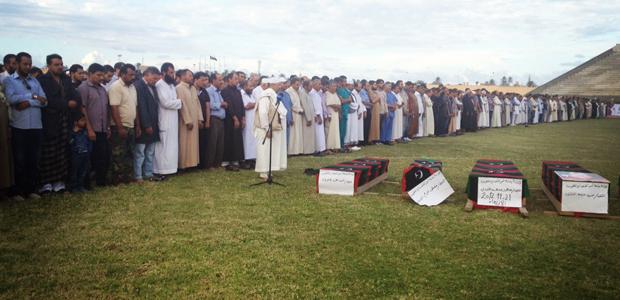Thousands Still Missing in Post-Revolution Libya
Hundreds gathered in Misrata’s City Stadium for a funeral prayer last month. (Photo: Marine Olivesi)
In the hallway of a Libyan government building, a grey-haired man flips through a neatly arranged binder holding 51 index cards – one for each phone call he’s received from people who volunteered information on his son’s whereabouts.
“I believe my son is still alive because of these 51 calls.”
The man’s name is Mohamed Elmahjoob Shaickh, as is his son. The 17-year-old disappeared in Tripoli on February 22, 2011. That day, he took to the street to support protesters in Benghazi who had just kick-started the Libyan uprising. Mohamed was with a group of high school friends when soldiers barged through the crowd, and everyone started running. His friends escaped, but Mohamed fell and was captured by security forces.
Thousands of Libyans went missing during the country’s revolution in 2011. Since then, many of the missing have been found — some alive, though most in graves. Government officials put the number now still missing at a little more than 2,000. For the families, the search for information on them is painfully slow.
After the overthrow of Gaddafi, Mohamed’s father visited prisons and distributed leaflets. His son’s picture still appears regularly on television, and each time he gets new tips, raising both hope and fear. His voice breaks as he reads notes from a phone call from Benghazi. Several people there claim they have spotted his son wandering the streets. They say the young man has lost his memory.
Shaickh quit his teaching job and he has been shuttling between Tripoli and Benghazi, pursuing every single lead himself. Technically, that’s the job of the Ministry of the Martyrs and Missing People. But Shaickh says that people at the ministry don’t believe his son is still alive.
“They say if he were alive, someone would catch him on the street. That’s why I have to do the job myself.”
Still, Shaickh goes to the ministry every week to beg for updates and keep up the pressure.
Esam Abdurzak Zreg, director of the Missing Department, says he understands that relatives are frustrated with the slow pace of the investigations, but so are the government workers.
“It’s a big challenge to us. We have many issues and we are still struggling to have a success in this ministry,” Zreg said.
Zreg says his department gets international help for DNA testing and staff training, but their ground work suffers from Libya’s institutional vacuum. Collecting information and connecting the dots is a daunting task in a country that still lacks a proper police force and justice system.
So far, the ministry has focused on registering the missing, and allocating a monthly pension to their families. About 2,135 cases have been filed in the past year.
Most of them involve opposition activists and fighters who disappeared during the revolution. But the figure also includes Gaddafi loyalists who vanished when the regime collapsed.
“Most of the cases that we register these days are from these families that didn’t trust the government. They were scared to say that we have a missing one who was working in militias under Gaddafi,” said Zreg. “Now they become more comfortable to come to us and ask for help.”
About 60 cases have been resolved in the past year. Zreg says most of those who were found alive had been in hiding in Egypt or Tunisia. Former rebel fighters, on the other hand, are more often found dead.
On a recent afternoon, hundreds gathered in Misrata’s City Stadium around the caskets of eight fighters who went missing in March 2011. One woman whose son’s name was Abdellaziz says she always had the feeling that he was coming back.
“I was waiting for him to knock on the door,” she said.
Abdellaziz’s mother hung on to hope for 20 months, until a mass grave was uncovered in November. They found the body of her son along with seven others.
Their portraits are on exhibit at the Revolution Museum in Misrata. Photos of revolution martyrs cover the walls, with one corner reserved for the missing.
While the museum opened before the revolution ended, many of the missing have since been found in jails in Tripoli. But the museum curators didn’t take down the photos. They just put stickers on the photos of the solved cases, indicating whether they turned up alive or dead.
Most of the missing photos now sport stickers – including the picture of Abdellaziz.
